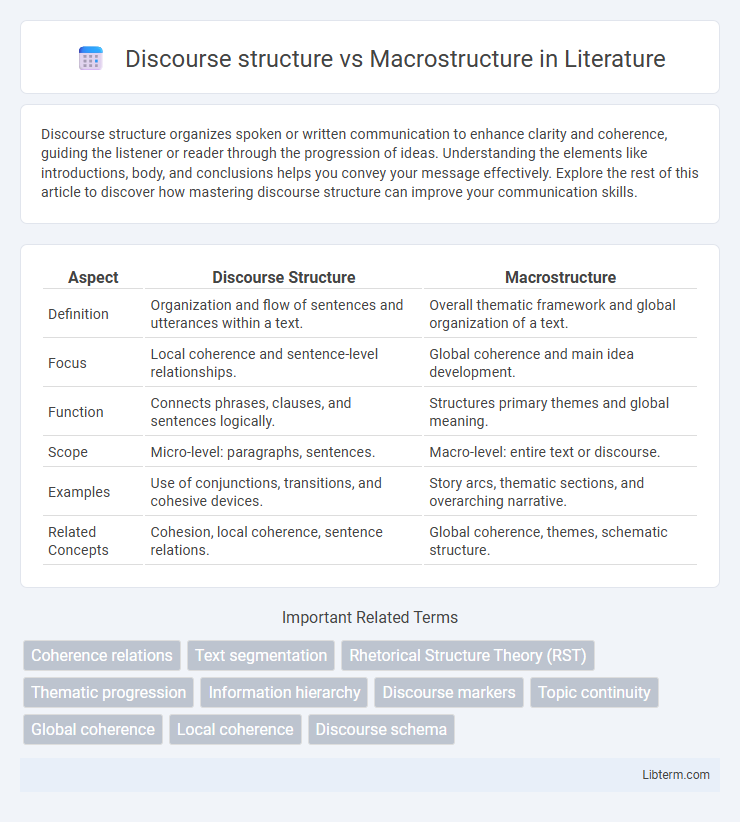Discourse structure organizes spoken or written communication to enhance clarity and coherence, guiding the listener or reader through the progression of ideas. Understanding the elements like introductions, body, and conclusions helps you convey your message effectively. Explore the rest of this article to discover how mastering discourse structure can improve your communication skills.
Table of Comparison
| Aspect | Discourse Structure | Macrostructure |
|---|---|---|
| Definition | Organization and flow of sentences and utterances within a text. | Overall thematic framework and global organization of a text. |
| Focus | Local coherence and sentence-level relationships. | Global coherence and main idea development. |
| Function | Connects phrases, clauses, and sentences logically. | Structures primary themes and global meaning. |
| Scope | Micro-level: paragraphs, sentences. | Macro-level: entire text or discourse. |
| Examples | Use of conjunctions, transitions, and cohesive devices. | Story arcs, thematic sections, and overarching narrative. |
| Related Concepts | Cohesion, local coherence, sentence relations. | Global coherence, themes, schematic structure. |
Introduction to Discourse Structure and Macrostructure
Discourse structure refers to the organization of ideas within a text, focusing on the relationships between sentences and paragraphs to ensure coherence and flow. Macrostructure involves the overall thematic framework or global meaning of the discourse, capturing the main topics and hierarchical organization of information. Understanding both discourse structure and macrostructure is crucial for effective communication, as it aids in comprehending how individual components contribute to the larger narrative or argument.
Defining Discourse Structure
Discourse structure refers to the organization and relationship of smaller units within a text, such as sentences and propositions, that contribute to its coherence and flow. It involves how ideas are connected through patterns like cause-effect, contrast, or elaboration to facilitate comprehension at a micro-level. Defining discourse structure is essential for understanding how individual components function together to create a meaningful, cohesive message within communication.
Understanding Macrostructure in Texts
Macrostructure in texts refers to the overarching organization and global meaning that emerges from the integration of individual discourse elements into a coherent whole. It provides a framework for interpreting the main ideas and thematic progression beyond sentence-level details, enabling readers to grasp the text's primary purpose and message. Understanding macrostructure involves analyzing how information is hierarchically structured, such as through topic sentences, summaries, and thematic repetitions, which guide cognitive processing and comprehension.
Key Components of Discourse Structure
Discourse structure consists of key components such as coherence, cohesion, and speech acts, which govern the organization and flow of information within a text or conversation. It emphasizes local relationships between sentences and utterances through linguistic devices like anaphora and conjunctions. In contrast, macrostructure refers to the overall thematic framework or global organization of a discourse, summarizing main ideas and underlying topics.
Features of Macrostructure in Communication
Macrostructure in communication encapsulates the overarching framework and main ideas that unify a discourse, providing coherence and guiding interpretation across a text or conversation. Key features include thematic organization, hierarchical arrangement of information, and the integration of global coherence by connecting individual propositions into a meaningful whole. This structure enables effective knowledge transfer and supports comprehension by highlighting primary objects and their interrelations within the communicative act.
Differences Between Discourse Structure and Macrostructure
Discourse structure refers to the organization and relationship of individual sentences and utterances within a text, emphasizing coherence and the flow of information at the local level. Macrostructure involves the overall global framework or thematic representation of the entire discourse, highlighting the main ideas, topics, and summary-level meaning. Differences between discourse structure and macrostructure lie in their scope, with discourse structure focusing on micro-level connections, while macrostructure addresses the holistic, abstract organization of content.
Functions of Macrostructure in Text Comprehension
Macrostructure in text comprehension involves the overarching organization and thematic framework that guides readers in synthesizing detailed information into coherent wholes. It functions to highlight essential ideas, create global coherence, and facilitate memory retention by structuring text hierarchically. Understanding macrostructure enables efficient navigation through complex discourse, enhancing both interpretation and summarization processes.
Role of Discourse Structure in Information Organization
Discourse structure organizes information by segmenting text into coherent units, such as sentences and paragraphs, enabling clearer understanding and logical flow. It governs relationships between these units through mechanisms like cohesion and coherence, facilitating efficient information processing and retrieval. This granular organization supports comprehension and memory by structuring content in a way that reflects human cognitive patterns.
Practical Applications in Linguistics and Discourse Analysis
Discourse structure involves the organization of sentences and propositions within a text, focusing on local coherence and the relationships between adjacent elements, while macrostructure refers to the overall global framework or thematic organization that shapes the entire discourse. In linguistics and discourse analysis, understanding discourse structure enables the analysis of coherence and cohesion at the micro-level, facilitating tasks like text segmentation and dialogue management. Macrostructure analysis supports applications such as summarization, argumentation mining, and thematic indexing by identifying overarching topics and discourse goals across extended texts.
Conclusion: Integrating Micro and Macro Perspectives
Discourse structure examines the local coherence and organization of sentences, while macrostructure focuses on the overall thematic framework and global coherence of a text. Integrating micro and macro perspectives enables a comprehensive understanding of meaning by linking detailed linguistic elements with broader conceptual patterns. This integration enhances text interpretation, facilitating improved communication and more effective information processing.
Discourse structure Infographic

 libterm.com
libterm.com